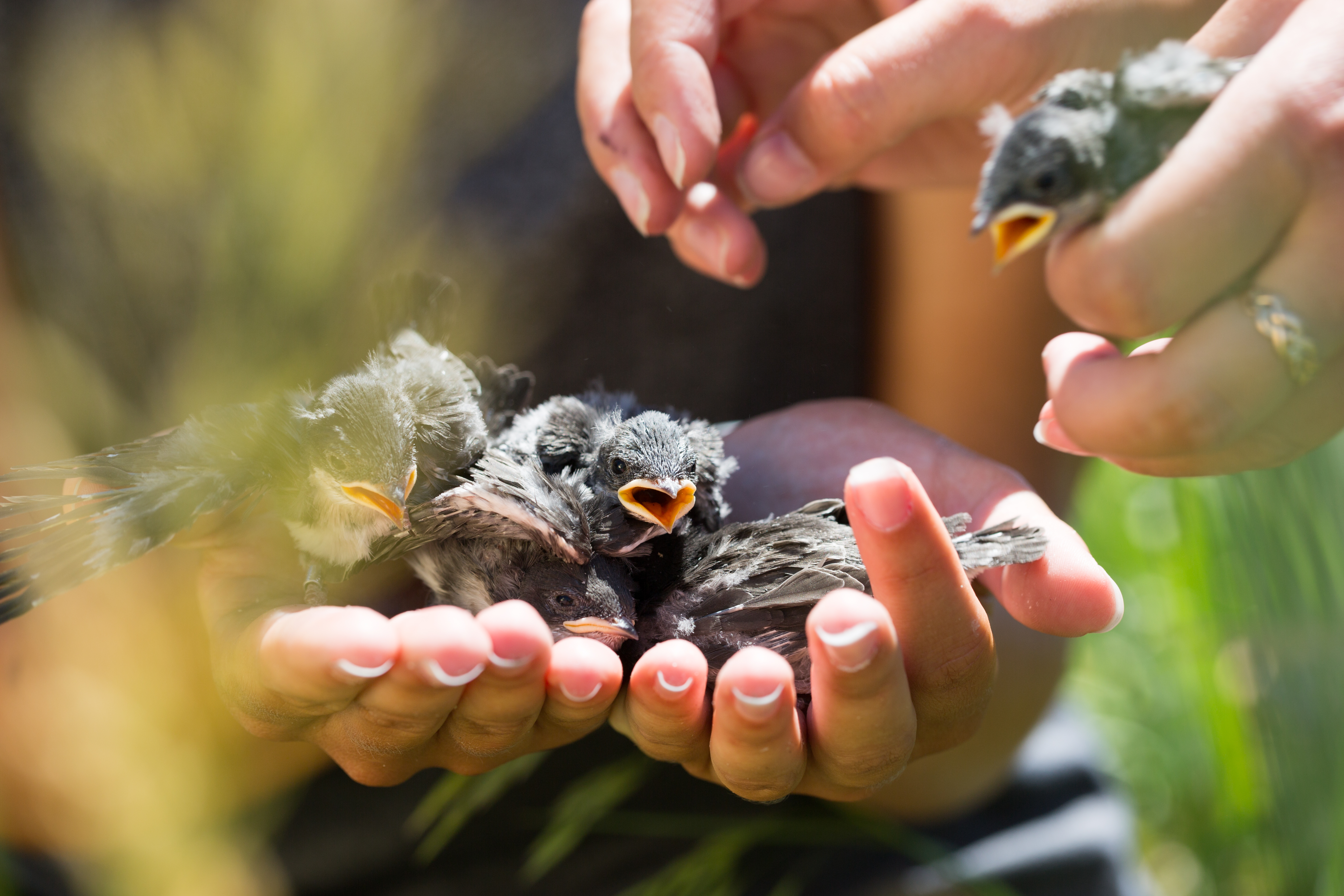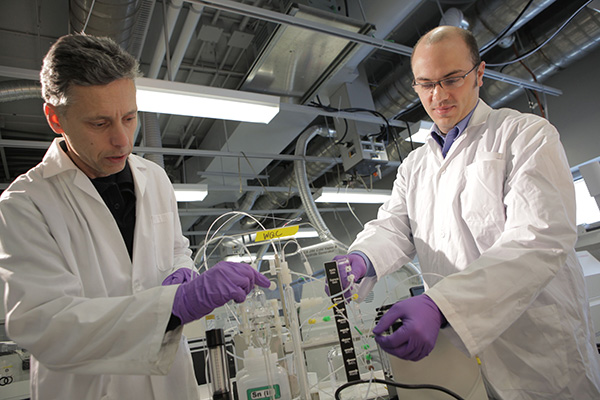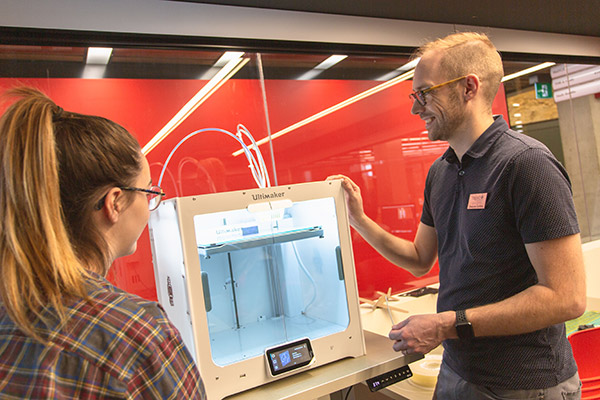
Animal Care Facilities
From alpacas to amphibians –Trent’s Animal Care department is typically home to two alpacas, around 100 mice, 300 rats, and resident Zebra Finches, fish, frogs and salamanders, to name a few. Most of the animal research being conducted at Trent is behaviour-based or fundamental biology research for which alternative research methods are not currently available. Trent’s Animal Care team provides the resident animals with the best possible care and enrichment, in line with industry best practice.

MASS SPECTROMETRY FACILITIES
Spanning two laboratories on Trent’s Symons Campus, the Trent Water Quality Centre (WQC) is the most comprehensive mass spectrometry facility in Canada. The facility currently houses 9 mass spectrometers, including the Bruker SolariX XR (eXtreme Resolution), one of only a few such mass spectrometers in Canada. This “super high resolution” instrument is capable of up to 10 million resolution, allowing for highly detailed analysis and accuracy. Another rare find in the WQC is the Plasma 1700, used for heavy isotope analyses in applications such as examining the origins of the solar system. With a 4 x 4 m2 footprint, this instrument enables the WQC to tackle extremely demanding applications that cannot be performed on other instruments. With its unique, highly sophisticated instrumentation, the WQC is an ideal partner for government, industry and other universities who require analytical services or training.

Bata Library Research and Innovation Cluster
Trent’s newly renovated Bata Library, home to three research centres, is a hub for research activity, offering researchers access to a host of resources, including:
- Odette Critical Making Studio: The studio is home to a variety of equipment and software, including various cameras and audio equipment, Ultimaker S5 printer, PFAFF Creative 1.5 sewing and embroidery machine, and a Cricut Maker.
- Data Visualization Lab: Provides faculty and students with a range of state-of-the-art tools, including advanced computers, spatial and statistical software, and 3D and VR analysis and display technologies.
- Library Research Consultation Centre: Trent’s experienced academic librarians, with their extensive knowledge of library resources and research procedures, are available to assist with your research questions and problems.
- MaDGIC (Maps, Data and Government Information Centre): Serving as the campus center for geospatial and statistical data, government publications, aerial photography, maps and other cartographic resources.
- Microforms Reading Room: The Microform Reading Room houses the library's collection of microfilm and microfiche.
- Trent University Archives: A regional repository for historical papers and records relating to the Trent Valley area and beyond.

DNA Laboratories
The DNA Laboratories at Trent University are equipped with state-of-the-art with instrumentation for robotic, high throughput, long-term genetic monitoring of natural populations, and supports a range of wildlife management research projects from within Trent, the Ontario Ministry of Natural Resources and Forestry, as well as other government and industry research programs.
11 On-Campus Nature Areas
Lush forest, wetlands, drumlins, streams, open fields and creeks. With roughly 1,400 acres of land situated on the banks of the Otonabee River and more than 30 kilometres of nature trails, Trent’s Symons Campus offers an ecologically diverse research landscape through its 11 on-campus nature areas.
Archaeological Research Labs
Trent’s archaeological research labs spans both the Durham GTA and Peterborough campuses. These lab facilities house all the equipment necessary for preparing archaeological samples for various chemical analyses. Among others, researchers have access to CF-EA-IRMS (for stable carbon and nitrogen isotope analysis of organics), MC-ICP-MS (for isotopic analysis of heavy elements and metals such as strontium, lead), GC-C/IRMS (for isotopic analysis of individual compounds), GC-MS/MS (for analysis of lipids) and a host of other instruments including ICP-MS, LC-MS, and FTICR-MS.
Aurora Greenhouse
Located in the DNA building on Trent’s Symons Campus, the Aurora Greenhouse is designed specifically for research applications, and provides unparalleled environmental performance in the control of temperature, humidity, air velocity, and light intensity. It also offers expanded research flexibility, year-round functionality and exact replication of experiments.
Biomaterials Research Laboratory
With fifteen-thousand square feet of laboratory space spread across four distinct laboratory groups, Trent University’s biomaterials research facilities allow for sector-leading research in the development and study of vegetable-oil based biomaterials.
Environmental Wind Tunnel
The Environmental Wind Tunnel is one of Trent’s best-kept secrets! This state-of-the-art facility is one of only a few facilities worldwide, designed to simulate the atmospheric boundary layer in both clean air and wind sediment transport. Each year tonnes of sediment are propelled through the tunnel as part of ongoing studies of dryland processes. Low temperature simulation (down to -10°C) and full humidity control are just some of the primary distinguishing features of this facility.
Ecological Field Station
The 110 ha (270 acres), James McLean Oliver Ecological Centre is a waterfront field station located near Bobcaygeon on Pigeon Lake, allowing the study of various habitats on the property and in the area, making it the ideal site for hands-on field research for both graduate and undergraduate students.
Forensics Crime Scene Facility
Trent’s Forensics Crime Facility sets new academic and environmental standards all at once, as a first-of-its-kind professional forensics training building constructed on a Canadian university campus—and with a goal to be Canada’s first zero-carbon building certified by the International Living Future Institute. The 4,100 square-foot building is a forward-thinking facility that pioneers approaches to training students and current practitioners in forensic science methodology. The new facility unites spaces for staging crime scenes, facilities for analyzing evidence and exhibits, as well as a classroom for reviewing and evaluating student performance.
Indigenous spaces
For more than 50 years, Trent has incorporated traditional teachings and perspectives into its programming. Indigenous spaces utilized by Trent researchers include:
- Nozhem: First Peoples Performance Space: The first publicly funded Indigenous Performance Centre in Canada.
- Ernest and Florence Benedict Gathering Space: Designed by 2 Row Architects, the Gathering Space has hosted many ceremonies, meetings and houses a large number of the original artwork.
- Mnidoowag A’Kiing (the Spirit Lands): Located in the traditional area – Tipi, Wigwam, Medicine Garden – Mnidoowag A'Kiing, provides a social fire for students, celebrates regular full moon and other ceremonies.
- The Gilbert Monture Oral History Lab: Serves as a hub for the production of oral history and digital story work. The lab offers computers with specialized software for the production of digital stories by faculty and students.
Living Lab
Trent University Durham GTA is fast gaining a reputation for impactful community-based research. The Living Lab, run in collaboration with Ontario Shores Centre for Mental Health Sciences, supports older adults who are experiencing chronic conditions associated with aging, including dementia. Through the Living Lab, student researchers have the opportunity to conduct research on aging and the conditions of aging in a real-world setting.
Language and Cognition Lab
For children, youth and adults with language impairments, communication is challenging. Researchers in the Language and Cognition Lab are focusing on the relationship between language and numeracy in early childhood and the relationship between language and reading; how language contributes to different aspects of social cognition, in particular theory of mind, in typical and atypical development; measuring executive function (i.e., inhibition, working memory, mental flexibility); and higher order language skills in children and adolescents.
Plant Physiology Lab
Work alongside some of the world’s leading experts in the study of plant hormones conducting field, physiological, molecular and genomic research. The lab has access to sector-leading instrumentation for gene expression and DNA marker work (real-time PCR, microarray chipmaker & reader, sequencers etc.) and the latest in mass spectrometry (LC-MS/MS, GC-MS/MS).
Rooftop Gardens
With approximately 3,500 m2 of green roof space on campus, the largest and most notable of Trent’s rooftop gardens is on the Environmental Sciences Building where students grow food that is later cooked and served in the Seasoned Spoon Café on campus.
Sustainable Agriculture Assets
With the world facing the socio-economic and ecological impacts of climate change, compounded by the global pandemic, there is a renewed focus on local and regional food security. The Trent Farm, located on the Symons Campus, offers the opportunity to dig deeper into sustainable, regenerative farming practices, such as good soil management, and investigating the impact of these practices. The University manages approximately 35 acres (14 ha) of farmland that supports the Trent School of Environment and the Sustainable Agriculture and Food Systems program. Additional farm assets include the Trent Vegetable and Market Gardens that are student-run, and other spaces such as the Trent Apiary and a Traditional Medicine Garden.
Trent-Fleming School of Nursing Trent Simulation Hub
The fully accredited (first of its kind in Canada) Trent Simulation Hub provides researchers and students with the opportunity to recreate real-world healthcare scenarios such as working in a hospital, providing care at home or in long-term care facilities, and working as a street nurse in a safe, risk-free environment. Simulations range from the use of high-fidelity mannequins to task trainers for skills development, and simulated participants that support relational skills. Mannequins can be used to simulate the birthing process, acute illness and chronic disease management. The Simulation Hub also collaborates and shares resources with local healthcare institutions, including Peterborough Hospice, Peterborough Regional Health Centre and Haliburton Highlands Health Services.
Trent Microenvironment Lab
The Trent Microenvironment Laboratory is the most comprehensive research facility of its kind among Canadian universities, and supports researchers in developing models that allow scientists to accurately predict the future impact of climate change, pollution and other negative pressures on biological, physical and chemical processes in the natural environment.


